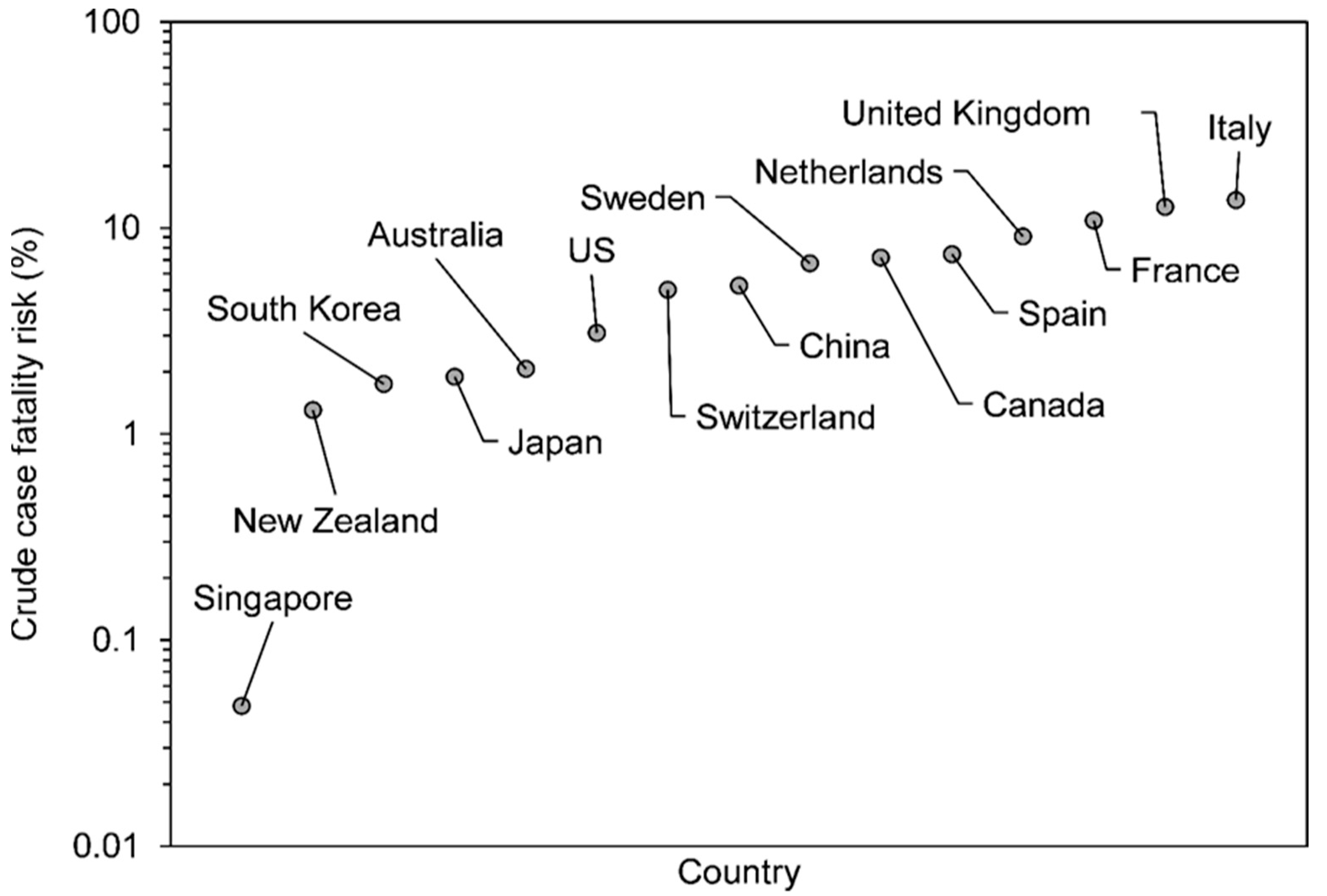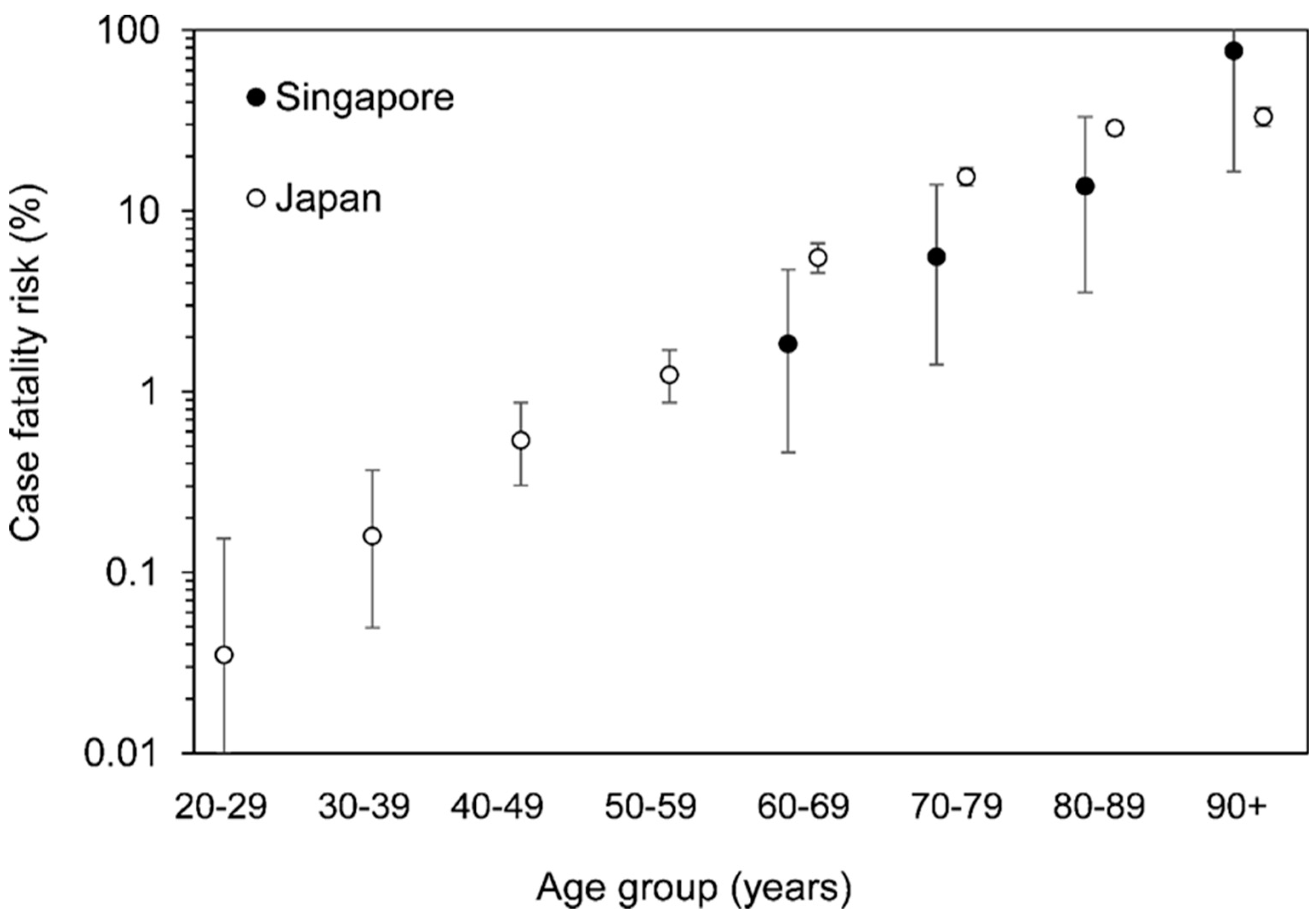A Comparison of Case Fatality Risk of COVID-19 between Singapore and Japan
Abstract
1. Introduction
2. Materials and Methods
2.1. Epidemiological Data
2.2. Statistical Estimation
2.3. Ethical Considerations
3. Results
4. Discussion
Author Contributions
Funding
Acknowledgments
Conflicts of Interest
References
- Johns Hopkins Coronavirus Resource Center. Mortality Analyses. 2020. Available online: https://coronavirus.jhu.edu/data/mortality (accessed on 9 September 2020).
- Wu, J.T.; Leung, K.; Bushman, M.; Kishore, N.; Niehus, R.; De Salazar, P.M.; Cowling, B.J.; Lipsitch, M.; Leung, G.M. Estimating clinical severity of COVID-19 from the transmission dynamics in Wuhan, China. Nat. Med. 2020, 26, 506–510. [Google Scholar] [CrossRef] [PubMed]
- Lau, H.; Khosrawipour, T.; Kocbach, P.; Ichii, H.; Bania, J.; Khosrawipour, V. Evaluating the massive underreporting and undertesting of COVID-19 cases in multiple global epicenters. Pulmonology 2020. [Google Scholar] [CrossRef] [PubMed]
- Miller, A.; Reandelar, M.J.; Fasciglione, K.; Roumenova, V.; Li, Y.; Otazu, G. Correlation between universal BCG vaccination policy and reduced morbidity and mortality for COVID-19: An epidemiological study. medRxiv. 2020. [Google Scholar] [CrossRef]
- Hooper, M.W.; Nápoles, A.M.; Pérez-Stable, E.J. COVID-19 and Racial/Ethnic Disparities. JAMA 2020, 323, 2466. [Google Scholar] [CrossRef] [PubMed]
- Ministry of Health, Singapore. Updates on COVID-19. 2020. Available online: https://www.moh.gov.sg/covid-19 (accessed on 21 July 2020).
- Nishiura, H.; Klinkenberg, D.; Roberts, M.; Heesterbeek, J.A.P. Early Epidemiological Assessment of the Virulence of Emerging Infectious Diseases: A Case Study of an Influenza Pandemic. PLoS ONE 2009, 4, e6852. [Google Scholar] [CrossRef] [PubMed]
- Kelsey, J.L.; Gold, E.B. Observational Epidemiology. Int. Encycl. Pub. Health 2016, 295–307. [Google Scholar] [CrossRef]
- Young, B.E.; Fong, S.-W.; Chan, Y.-H.; Mak, T.-M.; Ang, L.W.; Anderson, D.E.; Lee, C.Y.-P.; Amrun, S.N.; Lee, B.; Goh, Y.S.; et al. Effects of a major deletion in the SARS-CoV-2 genome on the severity of infection and the inflammatory response: An observational cohort study. Lancet 2020, 396, 603–611. [Google Scholar] [CrossRef]
- Ferretti, L.; Wymant, C.; Kendall, M.; Zhao, L.; Nurtay, A.; Abeler-Dörner, L.; Parker, M.; Bonsall, D.G.; Fraser, C. Quantifying SARS-CoV-2 transmission suggests epidemic control with digital contact tracing. Science 2020, 368, eabb6936. [Google Scholar] [CrossRef] [PubMed]
- Whitelaw, S.; A Mamas, M.; Topol, E.; Van Spall, H.G.C. Applications of digital technology in COVID-19 pandemic planning and response. Lancet Digit. Health 2020, 2, e435–e440. [Google Scholar] [CrossRef]
- The Japan Times. Downloads of Japan’s COVID-19 App Slow Despite Rising Infections. 2020. Available online: https://www.japantimes.co.jp/news/2020/07/21/national/japan-coronavirus-app-slow/ (accessed on 9 September 2020).
- Lipsitch, M.; Donnelly, C.A.; Fraser, C.; Blake, I.M.; Cori, A.; Dorigatti, I.; Ferguson, N.M.; Garske, T.; Mills, H.L.; Riley, S.; et al. Potential Biases in Estimating Absolute and Relative Case-Fatality Risks during Outbreaks. PLoS Negl. Trop. Dis. 2015, 9, e0003846. [Google Scholar] [CrossRef] [PubMed]
- Wu, J.T.; Ho, A.; Ma, E.S.K.; Lee, C.K.; Chu, D.K.W.; Ho, P.-L.; Hung, I.F.-N.; Ho, L.M.; Lin, C.K.; Tsang, T.; et al. Estimating Infection Attack Rates and Severity in Real Time during an Influenza Pandemic: Analysis of Serial Cross-Sectional Serologic Surveillance Data. PLoS Med. 2011, 8, e1001103. [Google Scholar] [CrossRef] [PubMed]
- Nishiura, H. Real-Time Estimation of the Case Fatality Ratio and Risk Factors of Death. Handb. Stat. 2017, 36, 167–174. [Google Scholar] [CrossRef]


Publisher’s Note: MDPI stays neutral with regard to jurisdictional claims in published maps and institutional affiliations. |
© 2020 by the authors. Licensee MDPI, Basel, Switzerland. This article is an open access article distributed under the terms and conditions of the Creative Commons Attribution (CC BY) license (http://creativecommons.org/licenses/by/4.0/).
Share and Cite
Kayano, T.; Nishiura, H. A Comparison of Case Fatality Risk of COVID-19 between Singapore and Japan. J. Clin. Med. 2020, 9, 3326. https://doi.org/10.3390/jcm9103326
Kayano T, Nishiura H. A Comparison of Case Fatality Risk of COVID-19 between Singapore and Japan. Journal of Clinical Medicine. 2020; 9(10):3326. https://doi.org/10.3390/jcm9103326
Chicago/Turabian StyleKayano, Taishi, and Hiroshi Nishiura. 2020. "A Comparison of Case Fatality Risk of COVID-19 between Singapore and Japan" Journal of Clinical Medicine 9, no. 10: 3326. https://doi.org/10.3390/jcm9103326
APA StyleKayano, T., & Nishiura, H. (2020). A Comparison of Case Fatality Risk of COVID-19 between Singapore and Japan. Journal of Clinical Medicine, 9(10), 3326. https://doi.org/10.3390/jcm9103326





